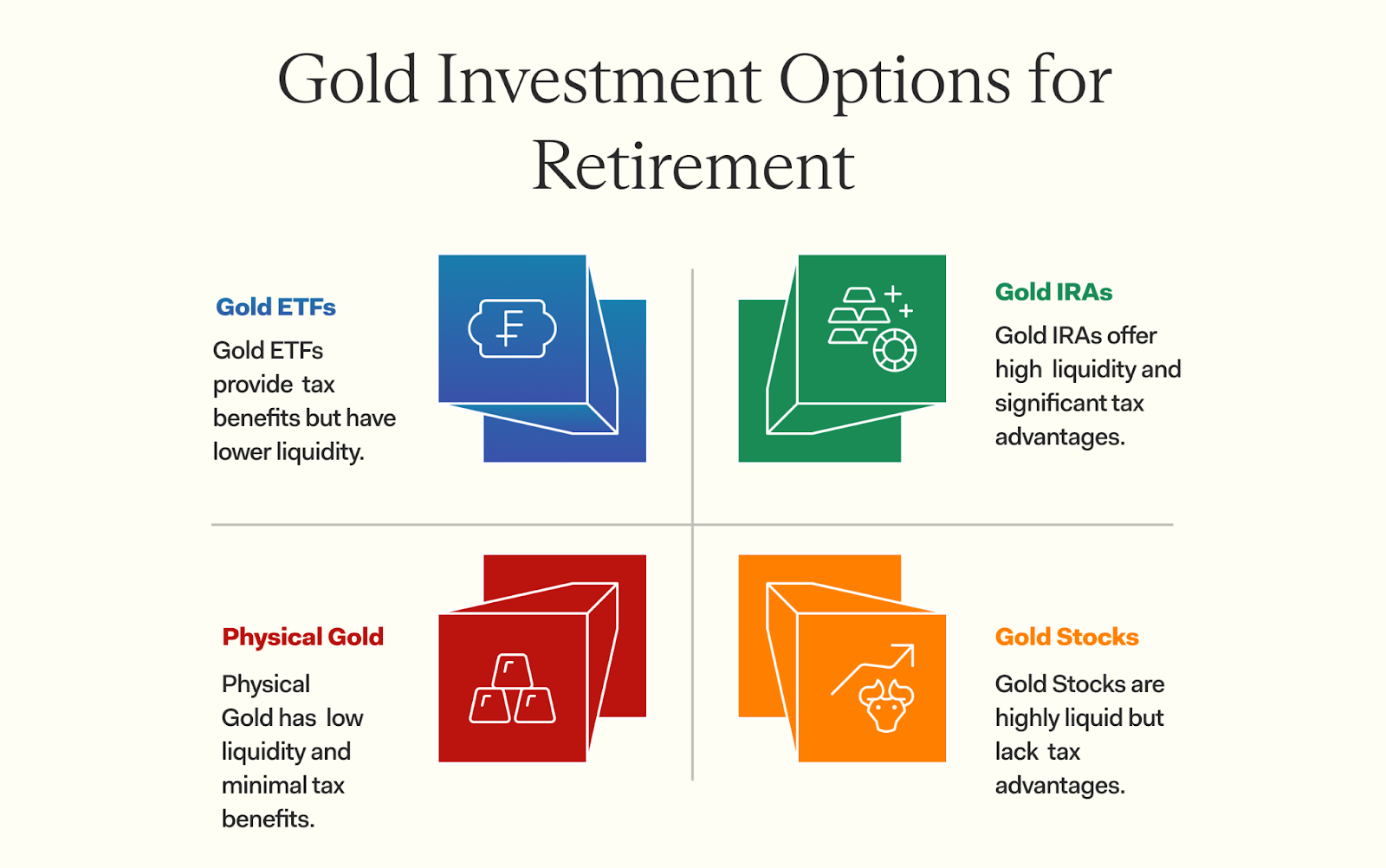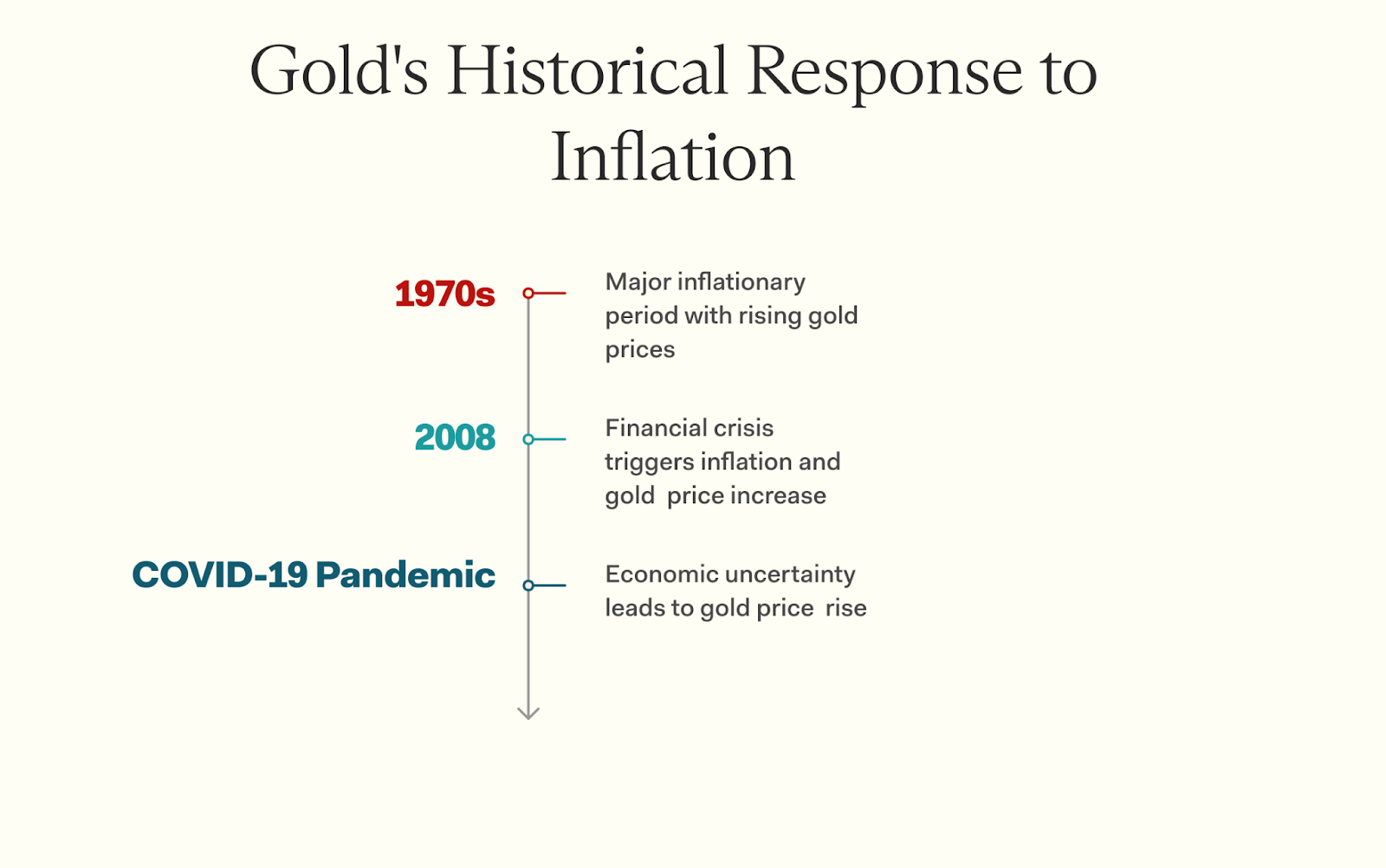Explore effective strategies for investing in gold to enhance your retirement planning. Discover practical tips to secure your financial future.
Wondering if gold should be part of your retirement strategy? This precious metal has historically preserved wealth during economic uncertainty and offers potential protection against inflation.
Gold provides portfolio diversification beyond traditional stocks and bonds.
This guide examines practical ways to add gold to your retirement plan, including Gold IRAs that allow physical precious metals within tax-advantaged accounts and direct ownership through coins and bars. Learn about the benefits of gold as a hedge against market volatility while understanding the storage costs, liquidity considerations, and other factors to weigh before investing.

Gold in your retirement portfolio can protect against inflation and diversify your investments. This strategy enhances security during retirement.
Gold acts as a hedge against inflation, which means its price often rises when the value of money drops. For many investors, this makes gold a strong choice during periods of rapid inflation.
History shows that gold prices have soared in times of high inflation, protecting savings from losing power.
Diversifying your investment portfolio with gold can provide stability.

Diversifying your portfolio means spreading out your investments. This can help reduce risk. Financial experts suggest that maintaining 5-10% of a retirement portfolio in gold can enhance its stability and resilience, especially during economic downturns. Gold is a key part of this strategy. It often moves differently than stocks and bonds. For example, during market turmoil or economic uncertainty, gold usually holds its value better.
Investing in types of gold like bullion coins, bars, or even gold mining stocks adds variety to your assets. This mix can protect you from losing money if other markets drop. Many seasoned investors see gold as a safe haven asset that brings balance to their investment choices.
It's important to note that including gold exchange traded funds (ETFs) or mutual funds in your retirement accounts can improve returns while keeping risks lower.
Gold acts as a safe haven during tough times. People often turn to gold when the economy struggles or during financial crises. This metal usually holds its value better than many other investments, like stocks or bonds.
When markets decline, the price of gold tends to rise, making it an attractive choice for investors seeking stability. Gold can also offer peace of mind because it is a tangible asset that you can hold physically.
Many also consider gold stocks and mining companies as ways to invest in this reliable resource.
Several investment options exist for those interested in gold. Some investors prefer holding physical gold, like bars and coins. Others favor gold ETFs or stocks from mining companies. Special accounts, like Gold IRAs, also help you save for retirement with gold assets.
Physical gold, like coins and bars, is a popular choice for investors. Many people prefer to hold physical gold as it provides a sense of security. Coins are often smaller and easier to store.
Gold bars can yield higher value since they come in larger weights.
Investing in these tangible assets keeps your money safe during times of economic uncertainty. Physical metals hold intrinsic value that can rise when other investments fail. Prices may fluctuate but owning gold means you have something real to rely on.
It's not just about cash flow; it's also about having an asset that endures through time.
Gold ETFs and mutual funds offer an easy way to invest in gold without owning physical gold. Gold Exchange Traded Funds (ETFs) track the price of gold. You can buy and sell them just like stocks on stock exchanges.
This means you gain exposure to gold's value without the hassle of storage or security.
Mutual funds pool money from many investors to buy various assets, including gold mining companies and physical gold. They diversify your investment, which helps lower risk. Both options allow for tax-advantaged growth in accounts like traditional IRAs and Roth IRAs.
Investors can choose based on their financial goals or risk tolerance. They're popular choices for those looking to include gold in retirement planning.
Gold stocks and mining companies provide another way to invest in gold. These investments can offer growth opportunities as the value of gold rises. Companies in this sector mine for physical gold or explore new areas for potential finds.
This means you can profit even if you don't own the actual metal.
Investing in these businesses may generate dividends, which adds income over time. Their prices can be volatile due to market shifts and geopolitical events. A strong performance often depends on various factors, like production costs and management skills.
For retirement planning, consider how these investments fit your strategy alongside traditional investments or a Roth Gold IRA.
A Gold IRA is a special type of account. It lets you hold physical gold and other precious metals in your retirement plan. You can invest in coins, bars, or bullion through this account.
These precious metal assets may help protect against inflation.
Setting up a Gold IRA involves some steps. First, choose an IRS-approved depository for storage. A reputable custodian will guide you through the process. With traditional gold IRAs or Roth gold IRAs, keep in mind contribution limits and tax rules based on after-tax dollars.
Investing in gold has some risks. Prices can change a lot, which might affect your savings. Storage and insurance costs can add up too, making it pricier than you think. Plus, there are taxes to consider when selling or withdrawing from accounts like a Gold IRA.
Gold prices can change dramatically. This volatility stems from multiple factors. Economic news, inflation rates, and market demand can all influence pricing. For example, during a financial crisis or when inflation rises, more people want to buy gold.
This increased demand often raises its price.
Investing in gold may not be stable like other investments. Some investors sell gold quickly to take advantage of high prices. They might also hold onto it for the long term as a safe asset against riskier markets.
It's important to understand that while gold can protect against economic trouble, its value can fluctuate widely over time. Keep this in mind as you plan your retirement investing goals.
Storing gold can be pricey. You need a safe place to hold your physical asset. This often means using an IRS-approved depository, which charges storage fees. These costs can cut into your returns.
Insurance is another expense. If you want peace of mind, you'll likely want to insure your gold investments. This adds more to the total cost of holding gold for retirement. It's smart to factor in these expenses when planning how much gold to invest in and what type of account works best for you, like a Gold IRA or other options available on the market.
Beyond storage and insurance costs, tax implications play a significant role in gold investing. If you sell gold for a profit, you might owe capital gains tax. This tax applies to the money you make from the sale.
Gold held in a Gold IRA can have different rules depending on the account type. Withdrawals from a Traditional Gold IRA are taxed as ordinary income, while withdrawals from a Roth Gold IRA are tax-free, provided the account has been open for at least five years and the account holder is over the age of 59½. Always consult with a financial advisor about these details to avoid surprises later on.
Investing in gold for retirement can be smart. Start by setting up a Gold IRA to hold your physical gold, and choose a trustworthy custodian for it. Look at different options based on how much risk you want to take.
Setting up a Gold IRA is straightforward. First, you need to choose a reputable gold IRA custodian. This company will help you manage your account and keep your assets safe. Look for one that has good reviews and experience.
Next, open the account with the appropriate financial consideration: contributions to a Traditional Gold IRA are typically made with pre-tax dollars, while contributions to a Roth Gold IRA are made with after-tax dollars. Purchase IRS-approved gold with a minimum purity of 99.5% to hold in your self-directed IRA.
Options include coins and bars, which can be stored in an IRS-approved depository.
Finally, keep track of your investment goals as market conditions change. Knowing what suits your risk tolerance helps guide decisions about buying or selling gold assets.
Picking a good Gold IRA custodian is key. They hold your gold and manage your account. Look for a custodian with good reviews and solid experience in gold investing. Ensure they are compliant with IRS regulations as this ensures adherence to rules concerning individual retirement accounts.
Consider fees too. Some custodians charge high storage or transaction fees that can eat into your profits, especially if you plan on holding gold long term. A trustworthy option helps protect your investment in gold and silver while keeping things easy to manage.
Investing in gold requires careful thought about risk. Each option has its pros and cons. Physical gold, like coins and bars, can be a solid choice for some. Yet, it needs safe storage and insurance—these costs matter.
Gold ETFs or mutual funds offer less hassle but come with market risks. Gold stocks tie your earnings to mining companies' success, making them more volatile. While a Gold IRA offers tax advantages, the specific benefits depend on whether the account is a Traditional or Roth IRA, and each has different growth and withdrawal implications.
It's worth noting that withdrawals from a Traditional Gold IRA are taxed as ordinary income, while qualified withdrawals from a Roth Gold IRA are tax-free if the account has been open for at least five years and the account holder is over the age of 59½.
Gold can be a powerful tool for retirement planning, offering inflation protection and portfolio stability. Whether through physical gold or a Gold IRA, it provides diversification—but be mindful of risks like price fluctuations and storage costs.
The key is aligning gold investments with your long-term goals. Ready to take the next step? Explore how to set up a Gold IRA and find trustworthy custodians. The more you know now, the stronger your financial future will be!
A SEP Gold IRA is a self-directed IRA that allows pre-tax dollars to be invested in IRS-approved gold, offering tax advantages for retirement planning.
Yes, one key benefit of investing in gold through a self-directed IRA is its tax-advantaged status. The money invested grows tax-deferred, and withdrawals are taxed as ordinary income at retirement.
The Internal Revenue Service has its own set of rules for gold investments. For instance, the gold must be stored in an IRS-approved depository and meet specific purity standards (99.5% purity for gold) to qualify as part of a self-directed IRA.
Yes, you can withdraw your investment from your SEP Gold IRA without penalty after reaching the age of 59½ as specified by the Internal Revenue Service guidelines. Remember, these withdrawals are subject to ordinary income tax.